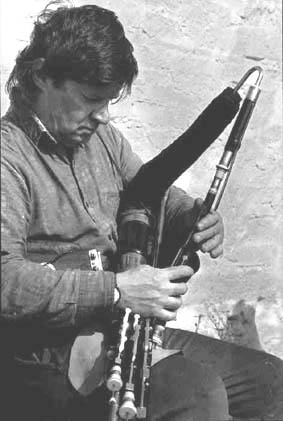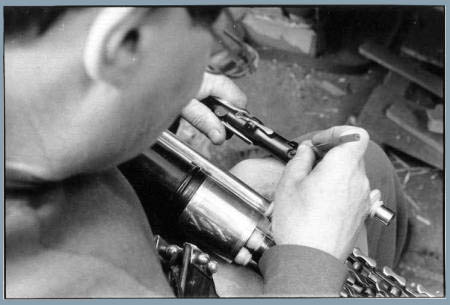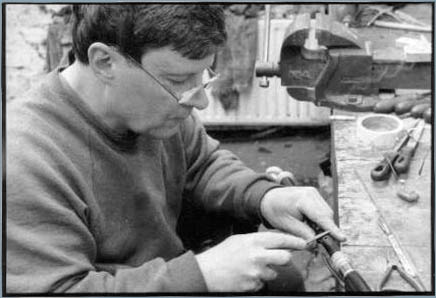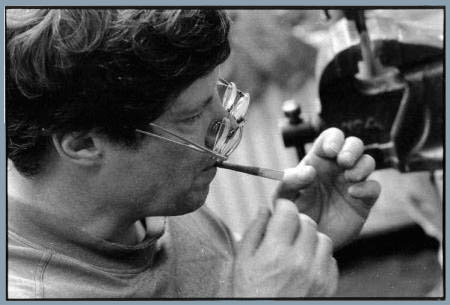|

geoff wooff:
getting started with regulators |
This article first appeared in "The Pipers' Review" 1996 Spring issue Vol. XV No. 2. Thanks to Wally Charm for allowing me to post this article here. The photo of Geoff is © Peter Laban.
Photo © Peter Laban  I have been trying for a number of issues to come up with a fairly detailed description on how to play and tune the regulators. I decided to write Geoff Wooff, the well known maker of those beautiful flat sets that we so often see and hear about, and he graciously agreed to give it a try. After much thought and a re-write, I believe that the following article will answer many, if not all, of the questions that will help you get those "regs" going. Geoff has given much time which I suspect would have been spent working on pipes up in the hills above Miltown Malbay in Co. Clare. I am sure you will all join with me in thanking him for this most informative article. (Editor)
I have been trying for a number of issues to come up with a fairly detailed description on how to play and tune the regulators. I decided to write Geoff Wooff, the well known maker of those beautiful flat sets that we so often see and hear about, and he graciously agreed to give it a try. After much thought and a re-write, I believe that the following article will answer many, if not all, of the questions that will help you get those "regs" going. Geoff has given much time which I suspect would have been spent working on pipes up in the hills above Miltown Malbay in Co. Clare. I am sure you will all join with me in thanking him for this most informative article. (Editor)
Many pipers own regulators, but are reluctant to get involved with them. If you would like to get your regulators going then the following points may, I hope, prove useful.
Getting in tune:
The regulators provide only a limited chordal accompaniment, or so it seems, but if your pipes are properly in tune then the variety can be extended considerably. The pipes, being a drone instrument, rely heavily on all notes being in tune with the drones. Only in this way can we achieve harmonic sweetness. Because the chanter has to be tuned to the drones one should forget modern, even tempered scales. If one tunes each note of the chanter and regulators so that it produces the most pleasing harmony with the drones, the scale that results is called "just intonation," and you then have a set of perfect intervals. If one can achieve this, and it can be done, then in theory many more notes can be joined in chordal harmony. This increases the possibility of regulator use, and sounds that are not usually possible on most other instruments will be produced.
I can imagine you now saying "what is this guy talking about?" Perhaps the following discourse will help. In modern usage the octave is divided mathematically -by speed vibrations-into twelve equal semitones. This "equal temperament" allows music to move from key to key and be equally out of perfect tune in any or all of them. It is a known fact if one tunes the pipes in this way they sound very sour because several of the chords made by the combination of drone and chanter will be slightly out of tune. If one uses "just intonation" or a set of "perfect intervals" then it is possible to combine notes that are adjacent in the scale to produce a chord. We normally call our drone D, and we tune it to the chanter by playing an A or G on the chanter. We are tuning by ear a perfect fifth or fourth, and we all should be able to do this. The tuned drone is then checked against the other notes of the chanter to see if all agrees, which in practice it rarely does. We can, however, establish the best pitch for our drone. It is then possible to pick any note on the scale and move the drone up or down until our ear tells us that we have achieved a nice chord between the drone and the chanter note. It then follows that from the direction which we have had to move the drone we now know what note on the chanter disagrees with the average, or in-tuned position, of the drone. If we then adjust any notes that are wrong-by using tape or wax on the holes-we may produce a perfect scale.
Photo © Peter Laban 
We must remember however that this perfect scale is only tuned to D. D is our first "key note," and with it we can combine more notes than any other "key note." For example, if E is a perfect second to the D, and F# is a perfect third, then we can combine them as a chord and it sounds good! Try that on a piano and hear what it sounds like-not too nice! Now that we have the chanter in tune and the drones going well it is time to start the same process with the regulators.
Electronic Tuners:
It is common practice these days to use quartz, crystal controlled, tuning devices which are available in most music stores. Most of these tuners work on "equal temperment" only and some degree of further understanding of musical scales will be needed to successfully use one to tune your pipes to a perfect scale. The tuner is most useful to maintain pitch standard, and when you are working with your tuning over a period of an hour you will notice that the overall pitch may rise as the reeds warm up. Maybe the best way to learn how to use the tuner is to take each chanter note in turn and tune only the small drone to it very carefully! Note how the resultant pitch of the chanter and the drone are measured by the tuner. You will find that the notes G and A are very similarly measured to the D of the drone (i.e. if the drone reads exactly D on the tuner than G and A will be close to the tuners' reference pitch for G and A). However, notes F#, B and C natural will each appear on the tuner as being flat when you have "ear" tuned the drone to each of them, and then refer the chanter note and the drone note to the tuner separately.
The notes F#, G, A, B and C natural can each be tuned by ear to the drone using the drone as a reference pitch, with a little practice. PRACTICE ! The "art" of playing the pipes is 10% ability, 40% practice, and 50% listening to good players. So get off the Internet and practice an hour each night. The improvement will impress you.
The two notes that are most difficult to tune to the drone are C# and E. C# has other problems in that you have to produce it from the same hole as C natural and some compromise is often needed. The E can best be made a "perfect" second by tuning the upper octave E to the small drone, thus producing a "perfect ninth" (it is easier to hear.) You then measure the pitch of this upper E and set the lower one an octave below it. I am not going to give you the exact values of these perfect intervals as you should find then yourself. You will then be better able to tune your pipes because of the skills you have learned. However, some of the references at the end of the article will give you all the figures you will need. So use the electronic tuner-a reference pitch and a comparator-with intelligence.
One very fine piper here in Ireland uses sticky tape on all the chanter holes and some fine Highland pipers do this too. If you set your chanter reed so that all the notes are sharp, you can attach tape to the upper edge of each hole to adjust and lower the pitch. In this way you have a simple correction tool for tuning your chanter. In a perfect world you would not need to do such a thing and I do not do it myself when making sets. No tape or wires up the bore of the chanter. That is fine for a new chanter and reed that is carefully matched and tuned. A chanter that has been indifferently tuned or where a perfect reed is not available, then tape and-things stuck up the bore-may render it in tune. If you partially cover a finger hole with tape or wax from the top side (edge of the hole nearest to the reed) you will lower the pitch of the note in both octaves. If you cover the hole from the lower side it will have more effect on the upper notes. If you inset a wire up the bore it will have the effect of lowering the pitch of the note mostly in the lower octave where the wire passes the note hole. However, the wire will have some effect on all the notes whose finger hole it passes.
Photo © Peter Laban  Setting up the regulators:
Setting up the regulators:
If you have been playing without regulators up till now you will be used to a certain air flow which will need to be increased to play more reeds. If you are already using all your strength and all your available air to drive your chanter and drones, you will have to consider making a lightish chanter reed without too much pressure change throughout its range. This will allow you to use your regulators without causing yourself bodily harm. When the chanter reed is adequate it is time to make regulator reeds. Instructions on making regulator reeds can be found in other publications. but I would recommend for the bass regulator to use a 14mm-15mm wide head.
Setting up regulators is time consuming, but not very difficult. Put in a reed that will cause all the notes to be a little sharp and maybe progressing sharper toward the lower notes. Attach a rush, which can be a very thin strip of cane or a piece of wire, to the tuning pin so it passes all the sharp notes. Check your tuning again and starting with the highest note add a little thread or wax to the tuning wire just above the reed side of the sharp hole. This will flatten the note. Start with the upper notes on each regulator as the added material may effect the lower notes. The "rush" will quiet the sound of the regulator. If it is too quiet then open the reed very slightly which will lower the pitch overall and you can then take off a little of the rushing material. This will bring up the strength of the tone and you can, by carefully adjusting , achieve volume, balance, and tuning. Do this with all the regulators. A useful tip when making regulator reeds-which do not need to overblow to the second octave-is to make the staple larger in diameter, which will lower the pitch. The staple bore has more effect on the lower octave than on the upper one.
Starting to use the regulators:
We now have the reeds in and in tune and other than getting everything right all we have to do is play them. The first thing is to get into a position that allows you to press most of the keys with the fleshy part of your hand while both hands are on the chanter. This will depend on the shape of both you and your pipes. Here some consideration should be paid to chair height, which should be level with your knee cap, and the possibility of using a shoulder strap. Experiment with different positions that will allow you to bring your wrist over the keys. This will be different for everyone due to the length of your arms, torso, and legs. I personally use a shoulder strap which is fitted around the main stock cup, up against the bag. This I find is the best place for it as it keeps the bag up underneath my arm and does not allow the body of the pipes to slip across my lap. If allied to the strap, I sit up straight and if possible on a firm stool where I can sit off the back of it a little where I can get in the most ideal playing position to press the regulator keys whilst playing the chanter. Lifting the shoulder of your bag arm and maybe leaning back away from the pipes will draw the regulators up your leg, and allow greater access for your lower hand to reach the keys. In this position, if you sway from side to side a little, you can observe the regulator keys moving back and forth under your wrist. This is a little like some fiddlers who rotate the fiddle with the left hand to change the angle for the bow to hit different strings. You will have to find your best position, so think ergonomically. It is not hard, but you will need many hours of work to find the position that is best for you.
It may be best to start with a tune in the key of G, as this affords the use of the second and third rows of keys. Start with the inside two regulators and press the keys for G and B. Play a tune you know well all the way through while holding these notes. This will teach you what hand manipulations you will need on the chanter as you go along. Now try the next lower rank, F# and A, and go through the tune again and again until you are tired of the discords and you will start to move back and forth to keep the harmony pleasing. When you can do this you are playing the regulators!
Some will find that they are moving the butt of the hand up and down on the keys while others will be able to move the wrist from right to left in order to activate the keys. Either technique is fine, but a sideways motion is more flexible and should be tried.
Chords and keys:
Playing the regulators is not easy and calls for much practicing, but it does put a "gloss" on your piping. It should not be used to cover up poor chanter work and it will not improve your rhythm. Finger chords played with the disengaged lower hand are more expansive in character, but are limited by what you can do with only one hand on the chanter. Once you have mastered the second and third rows of the inside regulators, some may prefer the middle and bass rows, move down to the lower G chord. I personally don't find this at all easy when playing my flat set for I am a short person. The very lowest D chord on the inside two regulators is beyond me, but is a very nice one for taller pipers. Vamping, using the bass by itself and then the inner two, is wonderful, but it really takes some coordination. Using a double tap beat like Johnny Doran is very enjoyable for audiences, but care should be exercised not to make a mess of it.
Use the A and F# (third row down) to harmonize with the D, E, F# A and C natural on the chanter. Use the upper G chord (second row down) to play with the notes D, E, G, F# and top A. Extending the top G chord to a C chord by moving the hand to open the C note on the inside regulator is good when harmonizing with the C, E, and G. The top row A and C will give you a D7 chord when used with the A, F# or D. Free hand D7 chords are also used with low A on the chanter.
Photo © Peter Laban  When you have the basics follow the rule of not playing the regulators all the time. Keep what you do simple so the tune is not spoiled. Listen to good players and think carefully how you might learn from them.
When you have the basics follow the rule of not playing the regulators all the time. Keep what you do simple so the tune is not spoiled. Listen to good players and think carefully how you might learn from them.
OK, this is all well and fine, but it will all sound bad if the pipes are not in tune. Let us assume that you have your pipes in tune, but they will not stay there. Seamus Ennis said, "If ever you get your pipes totally in tune, that is when your problems begin!" He was right, because you have to keep them there and there are no excuses. If they are not in tune you will then be subjected to, "but you had them in tune the last time we met." Try to tune your pipes in the atmosphere in which you will use them. Never leave them where it is cold, hot, damp, or dry. If you have to go through cold or hot weather on the way to where you will be playing be sure you allow ample time to take them out of the box in order to acclimate them as long as needed. Never play them in direct sunlight. New reeds will alter more than old ones. Try to make good ones and keep them forever.
Maintenance:
Maintenance is very important when you wish to play the regulators for the set has to be virtually air-tight. Check the bindings and corks regularly plus all the other places the set could leak. It is not really fair or reasonable to expect a reedmaker or pipemaker to do your maintenance or tuning. If I tune a set of pipes it is right for me, but the owner may play with more or less pressure, and this could negate the nice tuning. A pipe player really needs to do his own tuning and maintenance himself.
Geoff Wooff
This is a message I sent to the Uilleann Pipe Mailing List in reply to a question from Bernard Grigsby on tuning the regulators and I thought it might be of use here too.....
Regs are an unnecessary mystery. They are very easy to tune once you have a grasp on it. All you need is poster putty and possibly a bit of scotch tape. Occassionally you will need a thin rush eg. length of a guitar d string is a suitable size or a nice piece of hay. This can be used to flatten an entire reg or a section that needs a little flattening.
Dave Hegarty in his book "The Uilleann Pipe Reedmaker's Guidance Manual" (which is available for *free* via the NPU website incidentally) writes at length on the subject. It's the best reedmaking book out there and the troubleshooting section is excellent!
It is very important not to tune to a tuner. Tune each note to the chanter, it just doesn't work any other way.
- The rule of thumb for the rush or blu-tack placement is: *Above the note hole towards the reed end flattens that note. Below the hole a smidge can sharpen the note but not enough to rely on.*
- Get the top notes (reed end) in tune first without any rushs.
- Then work down the reg one note at a time.
- If the reed is suitable to the reg all you'll need to do is add a bit of blu-tack (poster putty) to the tuning pin.
- If there is only a short tuning pin on your set add a piece of brass wire fastened to the pin with some waxed thread.
- Warning: Do not add a big blob of blu-tac concentrated in one area, this will cause too much turbulance within the regulator and have too much of an effect on the lower notes. Instead work it "along" the tuning pin like a bun on a hotdog.
- Smooth out either end of your "bun" to try and avoid creating too much turbulance and therefore not affecting the lower notes too much.
Sometimes an ill fit reed can give strange results to your reg tuning eg. making a lower note sharp instead of flat. A temporary fix for this is to place a small piece of tape across the reed end of the hole, fine tuning in tiny increments until everything is right.
Remember, well tuned regs are a wonder to the ear and are well worth getting right so be patient tuning them and get them *bang on*.
Related Links:
- NPU - for Dave Hegarty's book "The Uilleann Pipe Reedmaker's Guidance Manual" available as a free download. This is the best value in piping history! www.pipers.ie
- Bostik "Blu-tack" the very best stuff for the job. Other immitations are just that and are either too sticky, too wet, or not sticky enough, get brittle over time, among other things. Here is a link to a store in the US that sells it online ::: Link »
- If you want a large quantity of Blu-Tack or want to go in on it with a few friends you can get it for a discount ::: here »
- You might also want to try this very good alternative which is cheaper in the States Mortite Rope Caulk: Link
|
|
 |
